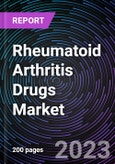This report comes with 10% free customization, enabling you to add data that meets your specific business needs.
Rheumatoid Arthritis Drugs Market based on Drug Class Type
- BS with Diarrhea (IBS-D)
- IBS with Constipation (IBS-C)
- Mixed-presentation IBS (IBS-M)
Rheumatoid Arthritis Drugs Market based on Route Of Administration
- Rifaximin
- Eluxadoline
- Lubiprostone
- Linaclotide
Rheumatoid Arthritis Drugs Market based on Sales Channel
- Prescription-based Drugs
- Over-the-counter Drugs
Rheumatoid Arthritis Drugs Market based on Geography
- North America
- Europe
- Asia Pacific
- Rest of the World
Various types of medications are used in the management of RA, including:
Nonsteroidal Anti-inflammatory Drugs (NSAIDs): NSAIDs are commonly used to relieve pain and reduce inflammation in RA. These drugs help alleviate symptoms but do not slow down the progression of the disease.Disease-Modifying Antirheumatic Drugs (DMARDs): DMARDs are a class of medications that work to slow down the progression of RA by targeting the underlying autoimmune response. Conventional DMARDs, such as methotrexate, sulfasalazine, and leflunomide, are often prescribed as first-line treatments. They help reduce inflammation, relieve symptoms, and protect joint structures.
Biologic Response Modifiers: Biologic DMARDs, also known as biologics, are a newer class of drugs that target specific molecules in the immune system involved in the inflammatory response of RA. Biologics, such as tumor necrosis factor (TNF) inhibitors, interleukin (IL) inhibitors, and Janus kinase (JAK) inhibitors, have revolutionized the treatment of RA and have shown significant efficacy in reducing symptoms, preventing joint damage, and improving long-term outcomes.
Corticosteroids: Corticosteroids are potent anti-inflammatory medications that can provide rapid relief of RA symptoms. They are often used for short-term management during disease flares or as a bridge therapy while waiting for other medications to take effect. Long-term use of corticosteroids is generally avoided due to their potential side effects.
The rheumatoid arthritis drugs market is highly competitive, with several pharmaceutical companies involved in research, development, and marketing of these medications. Advances in biotechnology and the emergence of biosimilars (lower-cost versions of biologic drugs) have increased treatment options and affordability.
The major leading companies of the rheumatoid arthritis drugs market are Abbvie Inc., Amgen Inc., Bristol-Myers Squibb Company, Eli Lilly And Company, F. Hoffmann-La Roche Ltd., Johnson & Johnson, Merck & Co., Inc., Novartis Ag (Sandoz), Pfizer Inc., Ucb S.A.
In addition to pharmaceuticals, the market also includes healthcare providers, rheumatologists, and other healthcare professionals who diagnose and manage RA. Physical therapists and occupational therapists also play essential roles in improving patients' physical function and quality of life.
As research continues and our understanding of the underlying mechanisms of rheumatoid arthritis expands, new therapeutic targets and innovative drugs are expected to enter the market. Personalized medicine approaches, such as precision therapies based on genetic and biomarker profiles, may also shape the future of RA treatment.
It's worth observing that market trends and dynamics can change over time. For the most up-to-date information on the current state of the cephalosporin market, it is advisable to refer to recent market research reports, industry publications, and engage with experts in the pharmaceutical sector. An exclusive analysis of all key geographical regions is included in the report which determines the potential opportunities in these regions.
Key reasons to purchase the report:
- Detailed information about the attributes which are generating growth in the rheumatoid arthritis drugs market in the forecast period.
- An exact estimation of the rheumatoid arthritis drugs market share and its contribution to the parent market is provided in the report.
- Further profiles of major competitors and their dynamic strategies are also included in the report.
Table of Contents
Companies Mentioned
- ELI LILLY AND COMPANY.
- JOHNSON & JOHNSON
- F. HOFFMANN-LA ROCHE LTD
- NOVARTIS AG (SANDOZ).
- AMGEN INC
- UCB S.A.
- BRISTOL-MYERS SQUIBB COMPANY.
- PFIZER INC
- MERCK & CO., INC
- ABBVIE INC








